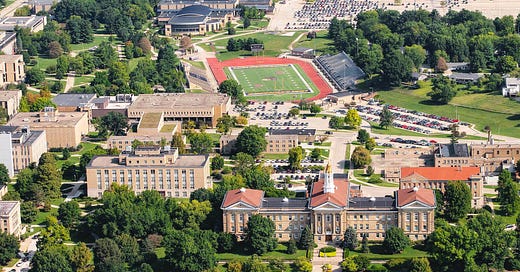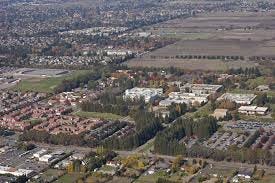Some College Towns Are On "The Wrong Side Of Where"
Towns that host mid-market colleges will struggle in the future. But that doesn't mean the lessons of great college towns can't be learned by these cities and others as well.
The bottom part of this post is behind the paywall but there’s plenty to read for free here as well.
No sooner had I published my Substack newsletter Monday extolling the virtues of college towns than The Wall Street Journal published a long piece saying college towns are dead.
I centered my piece on Athens, Georgia, home of the University of Georgia, a powerhouse institution with more than 40,000 students in a city of 128,000 residents. The WSJ centered its piece on Macomb, Illinois, home of Western Illinois University, which had 3,600 full-time students in residence (down from 4,500 two years ago) in a city of 15,000 people (down from 19,000 in 2010).
The campus of Western Illinois University
After my Monday post, a number of readers pointed out not only the WSJ piece but also larger trends that would seem to threaten universities: declining fertility and a coming dropoff in enrollment, declining state funding, research funding cutbacks from the Trump Administration.
The Wrong Side Of Where
All these trends are true, and they do indeed threaten the future of many, if not most, colleges and universities. But the contrast between Athens and Macomb highlights a simple reality about the Future Of Where in the United States: These days, a lot of college towns – like a lot of places – are on the wrong side of where.
The right side of where means to be in a location where demand and amenities are increasing. The wrong side of where means being in a location where demand and amenities are on the wane. Bottom line – as the WSJ article points out – is that places like Athens are on the right side of where and places like Macomb are not. To quote the WSJ article:
The Future Of Where depends entirely on revenue from paid subscriptions to survive. Help us out by becoming a free or paid subscriber today!
Large flagship universities—blessed with strong academic reputations and high-profile sports programs—continue to boost local economies. In such cities as Ann Arbor, Mich., University of Michigan, Madison, Wis., University of Wisconsin, and Gainesville, Fla., University of Florida, students fill dorms, restaurants and bars.
A Wall Street Journal analysis of 748 public four-year colleges and universities in all 50 states shows that full- and part-time enrollment at the most prominent state universities increased 9% in 2023 compared with 2015. At lesser-known regional state universities, enrollment fell 2%. The shift represents tens of thousands of students who have abandoned struggling college towns.
For example, even as Western Illinois University sees its resident population decline, enrollment Illinois’ flagship university – the University of Illinois at Urbana-Champaign – has increased 36% since 2010 and, according to the WSJ, the university doubled up students in dorm rooms last fall.
The reason? Again to quote the WSJ:
Of students choosing to enter college, more of them are aiming for prestigious universities, believing those diplomas will get them better jobs, said Richard Vedder, an economist at Ohio University who studies higher education. “It’s a flight to quality,” he said.
A flight to quality not only for colleges but also for college towns. Who wouldn’t rather be in bustling Champaign than declining Macomb?
The story behind this dichotomy is decades old, though it’s gotten more pronounced in recent years. After World War II – and especially in the ‘60s and ‘70s – the number of college-age folks exploded (the Baby Boomers). So did interest in going to college, especially among women. As a result, old teacher’s colleges like Western Illinois (originally called “normal schools”) expanded into state universities and most state university systems created a lot of new campuses. By 1999, Western Illinois had 15,000 students.
These campus served an important middle-market need, helping upwardly mobile kids get the serviceable four-year degrees they needed to enter the then-thriving white-collar job market. But they did not create many great college towns. Like the colleges themselves, the campuses were serviceable and utilitarian – often featuring not-so-distinguished Modernist architecture in not-so-distinguished suburban settings.
The Middle Market Suburban College
One example among thousands is my daughter’s alma mater, Sonoma State University.
Sonoma State, which opened during California’s boom time in 1961, is a perfectly fine unit of the California State University system, but nobody would mistake it for Anne Arbor. It’s located in Rohnert Park, a mostly single-family postwar suburb of Santa Rosa. Sonoma State’s campus is low-rise and car-oriented and so is most of the student housing – the upper division kids tend to rent single-family homes in surrounding neighborhoods and drive a short distance to one of the parking lots on campus. (I confess that my daughter spent muh of her time rowing in Petaluma and working at a restaurant in Point Reyes Station, both of which have high-quality place characteristics.)
The Sonoma State University Campus
Macomb is an example of a different type of campus – an old normal school turned into a state university in a small factory town located far from any large city that remains a middle-market college but over time has become the town’s biggest, if you will, factory. This type of town was hilariously rendered in Richard Russo’s comic novel Straight Man, which was later made into a TV series called Lucky Hank starring Bob Odenkirk. (The novel about a struggling state college is set in an old railroad town called “Railton” and is supposedly based on Russo’s own experience teaching at Penn State Altoona.)
This was all fine as long as the college population kept going up – and as the chart below shows, full-time four-year college enrollment doubled between 1970 and 2010. But it’s levelled off since then and is likely to decline in coming years. When it does, we will see more state colleges in particular on the wrong side of where. (We’ll also see more small private colleges fail, many of them in charming old villages, as the modern financial demands of higher education crush them. Wells College near Ithaca is a good recent example.)
All this does not mean, however, that we can’t learn from the great college towns that are out there, as I suggested on Monday. In fact, even more suburban college towns might be able to apply some of these lessons, because they contain a large and fundamentally walkable institution somewhere in the town.
So here are the lessons that I think any town – including suburban college towns – can learn from the classic college towns such as Athens that I talked about the other day. These lessons are valuable not just now but in the future as many college towns suffer from declining college enrollment.






